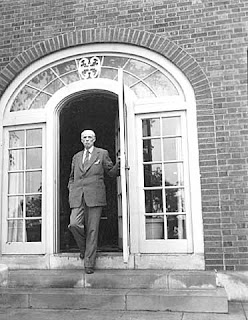What would you think if you heard a crash in the dining room, immediately looked in and saw that the cast iron heating register had come out of the floor and was now sitting a couple of feet away on the carpet? When this happened to me, I was in the next room and my six-year-old daughter in the adjacent parlor. We were mystified. The grate weighed over three pounds and couldn't have been lifted by the furnace blower. What moved it? My husband and I didn't know what to think.
Then, several months later in the winter, my husband had gone out to the garage for something when it happened again. He came back into the house to find our daughter completely freaked out. She had been watching TV in her room over the dining room when she heard the metallic crash from below and knew exactly what had caused it: the grate crashing onto the floor.
These incidents occurred six years after I had started collecting ghost stories, so I recognized the possibility that the cause was paranormal. Over the next thirty-some years my daughters and I, plus a number of our friends, witnessed other strange happenings in the house. Nevertheless, when these inexplicable events first occurred, we couldn't help but think that there must be a normal, not paranormal, explanation for them. But as the number of incidents grew, we had to conclude that, yes, there was a ghost afoot in the house.These experiences and my ever-expanding collection of ghost stories inevitably spurred me to research theories of what is known as a "ghost." If you've watched any of the numerous paranormal TV shows from the past two decades, you've probably found that there is an orthodoxy involving ghosts: They are spirits, entities, or demons that have materialized. You can discern their presence or contact them via mediums, psychics, ghost boxes, EMF meters, REM pods, etc.
Many ghost hunters say that they want to prove that ghosts are real. I don't. Nor do I care about the theories of what ghosts are. To me, the hundreds of stories from witnesses is enough proof that ghosts are "real" in some way.
This excerpt from my Goodreads review sums up why I like Clarke's approach so much:
"Clarke
covers it all, from poltergeists to séances to ESP to ghost
hunters--and more. He examines the hoaxes as well as the unexplained. My
personal favorite was the story of a cursed German WW I U-boat--which
Clarke calls 'a mobile haunted house.' I was fascinated by the tracing
of the story upon which Henry James based 'The Turn of the Screw,' my
favorite literary ghost story.
There are quite a few memorable
quotes, but the one I like best is by Harry Price, the first ghost
hunter: 'People don't want the de-bunk, they want the bunk.' Alas, one
need look no further for proof of this statement than the current spate
of paranormal TV shows, such as the laughable 'Alaska Monsters'. At
least the gullible viewers of these shows are not as dangerous as the
18th century 'flash mobs' of thousands that showed up, ready for action
against the alleged ghost--even if it meant tearing down the allegedly
haunted house. Now that's scary."
* * *The Chauncey Griggs House on Summit Avenue in St. Paul, based on the many stories told about it, the most haunted house in Minnesota. * * *
So what can I generalize about ghosts from personal experience and the stories I've collected? Ghosts do not perform on cue. The most commonly reported experiences are physical manifestations, like hearing footsteps or doors closing, or seeing lights go off or on, or having things move. Very few people report seeing full apparitions. Rarer yet are stories about witnessing past incidents or events, such as seeing a scene from a long-ago battle. Many stories concern single incidents, although some witnesses describe hauntings that last for months or years. Ghostly activity can happen over very long periods of time, and incidents are usually few and far between. Activity often fades as the years pass. Ghosts can be hostile or protective, interactive or passive. They can haunt houses, woods, apartments, battleships, skyscrapers, whatever. And yes, they can sometimes be busted (more on this in a future post).
Have you witnessed an explainable event? Many people do--for example, a door opening and closing when no one else is home. Some decide it's paranormal; others conclude it's an unsolvable mystery. Whatever they believe, or don't believe, these stories about uncanny events are endlessly fascinating.
Harry Price, the first ghost hunter. "People don't want the de-bunk, they want the bunk."








No comments:
Post a Comment